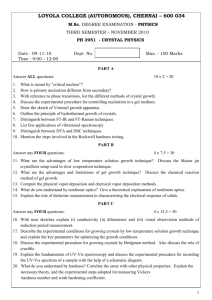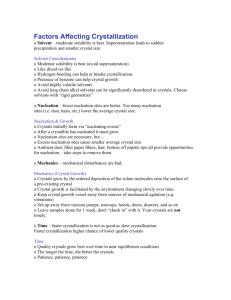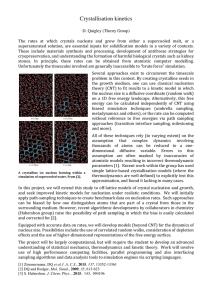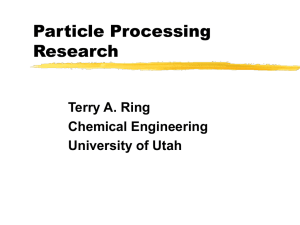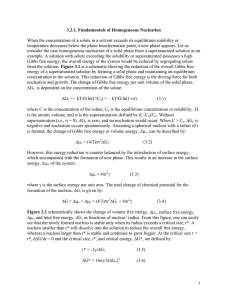A computational approach to understanding crystal nucleation and growth
advertisement
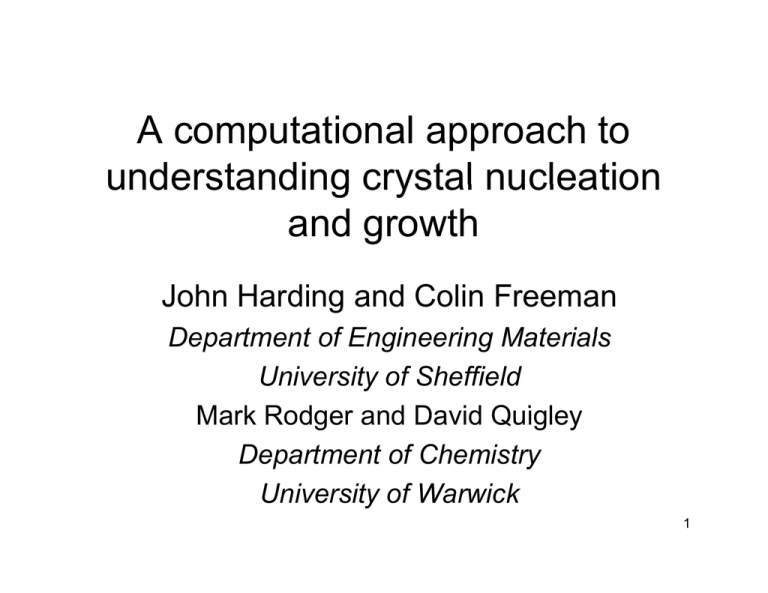
A computational approach to understanding crystal nucleation and growth John Harding and Colin Freeman Department of Engineering Materials University of Sheffield M k Rodger Mark R d and dD David id Q Quigley i l Department of Chemistry University of Warwick 1 Biomaterials at the micro and nanoscale F 3O4 nanoparticles Fe ti l nanocrystalline y hydroxyapatite paste (a) Fe3O4 crystals in magnetotactic bacteria (courtesy Patrick James, Univ. of Southampton, UK), (b) Ostim® nanocrystalline hydroxyapatite paste (courtesy, Franz-Xavier Huber), Huber, F. X.; Belyaev, O.; Hillmeier, J.; Kock, H. J.; H b C Huber, C.; M Meeder, d P P. JJ.; Berger, B I B. I. B Musculoskeletal M l k l t l Di Disorders d 2006 7, 2006, 7 14 SiO2 diatom frustrule red abalone plates (c) amorphous SiO2 diatom frustule (courtesy Kenneth Bart, Hamilton College, Clinton NY), and (d) Nacreous plate structure in red abalone; Tian, Z. R. R.; Voigt, J. A.; Liu, J.; McKenzie, B.; McDermott, M. J.; Rodriguez, M. A.; Konishi, H.; Xu, H. F. Nat. Mater. 2003,, 2,, 821. 2 Hierarchy in biomaterial systems (A) Consolidated silica nanoparticles deposited around a preformed organic axial filament (shown on the right). (B) Lamellar structure of spicule made of alternating organic and silica layers. Inset depicts the organically glued interlayer region. (C) Bundling of spicules. (D) (Right) Vertical and horizontal ordering of bundled spicules forming a square-lattice square lattice cylindrical cage with every second cell reinforced by diagonal elements. (Left) The node structure. (E) Cementation of nodes and spicules in the skeletal lattice with layered silica matrix. (Inset) Fiber-reinforced composite of an individual beam in the strut. (F) Surface ridges protect against ovalisation of the skeleton tube (G) Flexural anchoring of the rigid cage into the soft sediments of the sea floor.. (J.C. Weaver, J. Aizenberg, G.E. 3 Fantner et al J. Struc. Bio. 158, (2007) 93.) The seven-fold hierarchy of bone Level 1: Isolated crystals from human bone (left side) and part of an unmineralized and unstained collagen fibril from turkey tendon Level 2: TEM micrograph of a mineralized collagen fibril . Level 3: TEM micrograph of a thin section of mineralized turkey tendon. Level 4: Four fibril array patterns of organization found in bone bone. Level 5: SEM micrograph of a single osteon from human bone. Level 6: Light micrograph of a f t d section fractured ti through th h a ffossilized ili d (about 5500 years old) human femur. Level 7: Whole bovine bone (scale: 10 cm). Wiener & Wagner Annu. Rev. Mater. Sci. 1998.28:271-298. 4 A hierarchy of methods Atomistic Simulations Electronic Structure Many processes occur Based on Born Model of Calculations To Model the on a time scale too long Solids. Highly accurate tobiological be studied via METADISE (Watson et al) atomistic calculations Energy Minimisation interface with Results from relatively DL_POLY (Smith) minerals we small are used Dynamics RMolecular Results ltsystems are th therefore f will to fit and verify potential need to make used to develop mesoPolarisability described models. models (based on DPD use of simulation using g Shell Model for example in this case) techniques Such models canused also to: Atomistic Calcs Systems typically contain based onatoms aatomistic suggest further Scan configuration 10 – 100000 and of calculations space the order of in size range ofnm length (identify important scales andGood …but Requires Results from mesoscale systems) accuracy Quality Potential calculations couldetc also Study Interfaces Parameters be fed into continuum (Where system to large) composite models 5 Coccoliths – crystal control J.R. Young, S.A. Davis, P.R. Bown, and S. Mann 6 Journal of Structural Biology 126, 195–215 (1999) Structure of an eggshell. 7 What are the issues? • Nucleation takes place in a container (vesicle) that permits control of the solution chemistry. Organic molecules are present both in solution and in an insoluble matrix – both can control the growth • The Th systems t grow in i the th presence off water. t A proper treatment of the water structure is essential • Classical Cl i l ((unit it b by unit) it) nucleation l ti models d l are often ft inappropriate. In many cases, the system first nucleates nanoparticles and then assembles them them. • The hierarchy both invites the use of a set of models linked together and necessitates this approach. 8 Non-classical crystallisation 9 Crystal nucleation and growth H. Cölfen and S. Mann, Angewandte Chemie International Edition, 2003, 42, 2350-65 (adapted). 10 Mesocrystals From mesocrystals to single crystals by changing the solution Calcium carbonate crystals precipitated from a solution containing Ca and PEO22-PNaStS49 at a fixed [Ca]:[S] molar ratio of 1.25:1 and Ca concentrations of (a) 10, (b) 5, (c) 2.5, (d) 1, (e) 0.5, and (f) 0.1 mM. These crystals are representative of the entire sample population. Alex N. Kulak, Peter Iddon, Yuting Li, Steven P. Armes, Helmut Co¨lfen, Oskar Paris, Rory M. Wilson, and Fiona C. Meldrum, J. AM. CHEM. SOC 2007, SOC. 2007 129, 129 3729-3736 11 The problem of force-fields Slab of Mineral All atoms freeMolecule to relax Organic / Bio H b Has been extensively ti di l M Many wellll d derived, studied force and for many generic fields exist minerals potential eg g CVFF, reliable CHARMM, parameters exist. AMBER, COMPASS For CaCO3etc these include DREIDING models byupdated Pavese have et al Regularly updated, and several and been appliedby to Gale a wide collaborators. variety of situations. B th have Both hmoreb been Th These often ft include i l d successfully applied to all aqueous conditions. polymorphs, flat and stepped surfaces. 12 Water D Density Relative to Bulk The Effect Of Water 3 2.5 2 1.5 1 0.5 0 0 2 4 6 Distance from Surface 8 Clear Layering of Water upto 10A from surface I broad In b d agreementt with ith earlier experimental data 13 Kerisit and Parker JACS 126:10152 (2004) Simulating nucleation • There are a few direct simulations of nucleation – usually need high subcooling or supersaturation • Can bias the simulation in various ways – most methods involve adding a bias potential to the simulation but vary in how this is done simulation, done. – all methods face the same issue – how to choose the direction to bias it in – metadynamics (Laio and Parrinello) is one of the most successful of recent methods. 14 Metadynamics Illustrated Small Gaussian bias potentials are added to current location in order parameter space at intervals Taug. Pushed over free energy barriers into unexplored regions. Provided motion of order parameters is adiabatically slow, the free energy is recovered as the negative of the total bias. 15 Metadynamics Approach [Laio & Parrinello P.N.A.S. 99 12562 (2002)] • Describe system in terms of order parameters λ = ((λ1,λ2….λM) which describe nucleation/growth g p pathway. y The derivative of the Gibbs free-energy w.r.t. λ is evaluated via MD or MC. • “Thermodynamic “Th d i fforce”” acting ti on th the order d parameters t iis : • Augment Ftherm with Vaug(λ1,λ λ2….λ λM) – history dependent. dependent th – Pushes the system away from previously visited λ. – Grow a bias potential to overcome energy barriers. – Pushed P h d iinto t rare configurations fi ti tto overcome entropic t i barriers. 16 Order parameters Q6 Steinhardt order p parameter [ Steinhardt et al. Phys.Rev.B. 28 784 ((1983)) ] k runs over all nearest neighbour separation vectors. Contributions reinforce for an ordered system, and cancel for a disordered system. 17 Phase assignment Ca2+ CO32- • Based on computation of local per-ion order parameters and comparison to bulk reference values. 18 Changing the size of the cluster 75 calcite 192 75 units minimum “B” B G/kBT vaterite DQ Quigley g y and PM Rodger, g J. Chem. Phys. 128 (2008) 221101 19 The effect of adding a protein G/kBT G/kBT Quigley, Q i l F Freeman, Rodger, Harding in preparation G/kBT G/kBT • • • • Freeze protein+nanoparticle, equilibrate water for 300ps. Heat in 50k increments of 300ps up to 310k. Perform ~40 ~40,000 000 metadynamics steps as in pure water water. Depending on orientation can stabilise any of the three 20 accessible phases (about 22000 water molecules not shown). Adsorption: polysaccharides M. Yang, S.L. Stipp, J.H. Harding. Crys. Eng. Des. (2008) in press surface galactose mannose (00.1,CO3 2-) -93.7 -40.7 -60.4 -40.8 -58.9 -91.5 -81.6 23.2 -51.6 -50.4 -41 2 -41.2 -43 7 -43.7 -73 4 -73.4 -36 4 -48.7 -36.4 -48 7 -50.8 -19.0 -81.8 -31.7 -45.8 -22.9 -29.6 -60.6 -55.5 -42.1 -11.1 28.9 0.6 -45.2 -6.7 2.0 15.7 1.0 -24.0 -1.3 -10.6 10 6 21 9 21.9 12 5 12.5 96 9.6 84 8.4 xylose rhamnose average polar surface (1-2.0) acute stepped surface (31 8) (31.8) acute stepped surface (10.0) planar surface (10.4) planar surface ((21.4)) obtuse surface (31.16) obtuse surface (00.1,C (00 1C a2+) polar surface 21 Absorption – peptides • Large number of cases to consider • Need free energies not energies – experimental evidence is clear that many cases are entropically driven although some are enthalpically driven. • Experimental evidence that in some cases the presence of organic molecules speeds up the growth, in others it slows it down down. M. Yang, unpublished work 22 Surface – Protein Build 8-layer calcite slabs ~10000 sqÅ area. Highest and lowest energy configurations selected for each position and the system is solvated with ~20,000 water molecules. Protein placed in 6 different positions on the surface and in 64 different orientations to explore various configurations. Run for 200 ps in vacuum. C.L. Freeman, unpublished work R ffor 2 ns. Run Highest and lowest energy positions selected and run until the system shows stability. 23 Residues and the Surface (2) (1) 3x ARG 5 ARG 5x 3 SER 3x 3 ALA/GLY 3x ARG – N-H hydrogen bonds to carbonate oxygen and N-Ca. SER – O-H O H hhydrogen d bbonds d tto carbonate b t oxygen and d O-Ca. OC ALA/GLY – N-Ca/C=O-Ca of residue backbone. 24 25 What needs to be done • Investigate the effect of internal water on the transformation of nanoparticles • Investigate effects of several nanoparticles and proteins proteins, polysaccharides, polysaccharides peptides • Devise mesoscale models to use the information from atomistic simulations and build models for mesocrystal formation. • Do this all for calcium phosphates (including apatites) where there is as least as much data as for carbonates. 26

